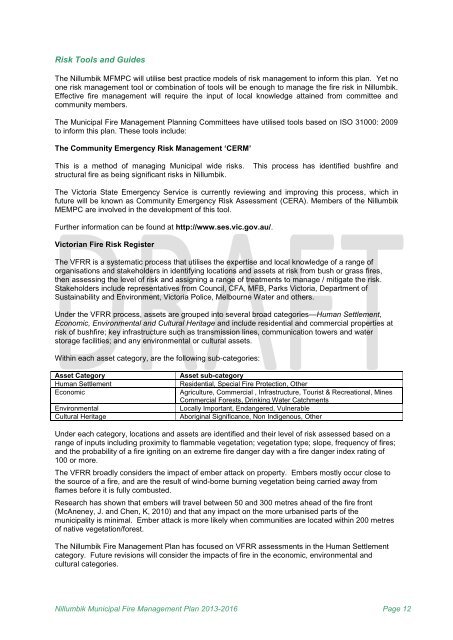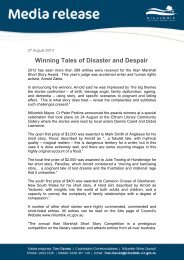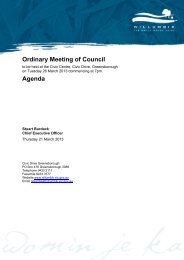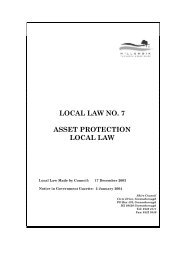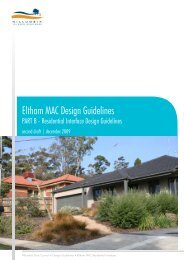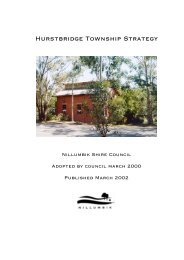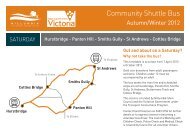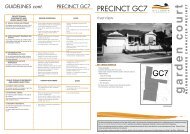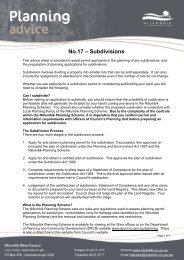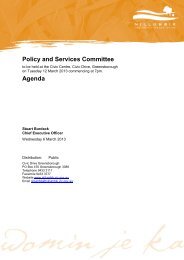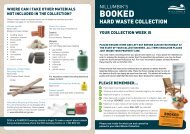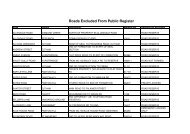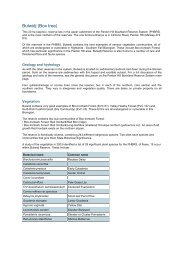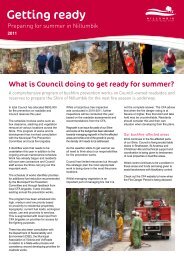Municipal Fire Management Plan 2013â2016 - Nillumbik Shire ...
Municipal Fire Management Plan 2013â2016 - Nillumbik Shire ...
Municipal Fire Management Plan 2013â2016 - Nillumbik Shire ...
Create successful ePaper yourself
Turn your PDF publications into a flip-book with our unique Google optimized e-Paper software.
Risk Tools and GuidesThe <strong>Nillumbik</strong> MFMPC will utilise best practice models of risk management to inform this plan. Yet noone risk management tool or combination of tools will be enough to manage the fire risk in <strong>Nillumbik</strong>.Effective fire management will require the input of local knowledge attained from committee andcommunity members.The <strong>Municipal</strong> <strong>Fire</strong> <strong>Management</strong> <strong>Plan</strong>ning Committees have utilised tools based on ISO 31000: 2009to inform this plan. These tools include:The Community Emergency Risk <strong>Management</strong> ‘CERM’This is a method of managing <strong>Municipal</strong> wide risks.structural fire as being significant risks in <strong>Nillumbik</strong>.This process has identified bushfire andThe Victoria State Emergency Service is currently reviewing and improving this process, which infuture will be known as Community Emergency Risk Assessment (CERA). Members of the <strong>Nillumbik</strong>MEMPC are involved in the development of this tool.Further information can be found at http://www.ses.vic.gov.au/.Victorian <strong>Fire</strong> Risk RegisterThe VFRR is a systematic process that utilises the expertise and local knowledge of a range oforganisations and stakeholders in identifying locations and assets at risk from bush or grass fires,then assessing the level of risk and assigning a range of treatments to manage / mitigate the risk.Stakeholders include representatives from Council, CFA, MFB, Parks Victoria, Department ofSustainability and Environment, Victoria Police, Melbourne Water and others.Under the VFRR process, assets are grouped into several broad categories—Human Settlement,Economic, Environmental and Cultural Heritage and include residential and commercial properties atrisk of bushfire; key infrastructure such as transmission lines, communication towers and waterstorage facilities; and any environmental or cultural assets.Within each asset category, are the following sub-categories:Asset CategoryHuman SettlementEconomicEnvironmentalCultural HeritageAsset sub-categoryResidential, Special <strong>Fire</strong> Protection, OtherAgriculture, Commercial , Infrastructure, Tourist & Recreational, MinesCommercial Forests, Drinking Water CatchmentsLocally Important, Endangered, VulnerableAboriginal Significance, Non Indigenous, OtherUnder each category, locations and assets are identified and their level of risk assessed based on arange of inputs including proximity to flammable vegetation; vegetation type; slope, frequency of fires;and the probability of a fire igniting on an extreme fire danger day with a fire danger index rating of100 or more.The VFRR broadly considers the impact of ember attack on property. Embers mostly occur close tothe source of a fire, and are the result of wind-borne burning vegetation being carried away fromflames before it is fully combusted.Research has shown that embers will travel between 50 and 300 metres ahead of the fire front(McAneney, J. and Chen, K, 2010) and that any impact on the more urbanised parts of themunicipality is minimal. Ember attack is more likely when communities are located within 200 metresof native vegetation/forest.The <strong>Nillumbik</strong> <strong>Fire</strong> <strong>Management</strong> <strong>Plan</strong> has focused on VFRR assessments in the Human Settlementcategory. Future revisions will consider the impacts of fire in the economic, environmental andcultural categories.<strong>Nillumbik</strong> <strong>Municipal</strong> <strong>Fire</strong> <strong>Management</strong> <strong>Plan</strong> 2013-2016 Page 12


